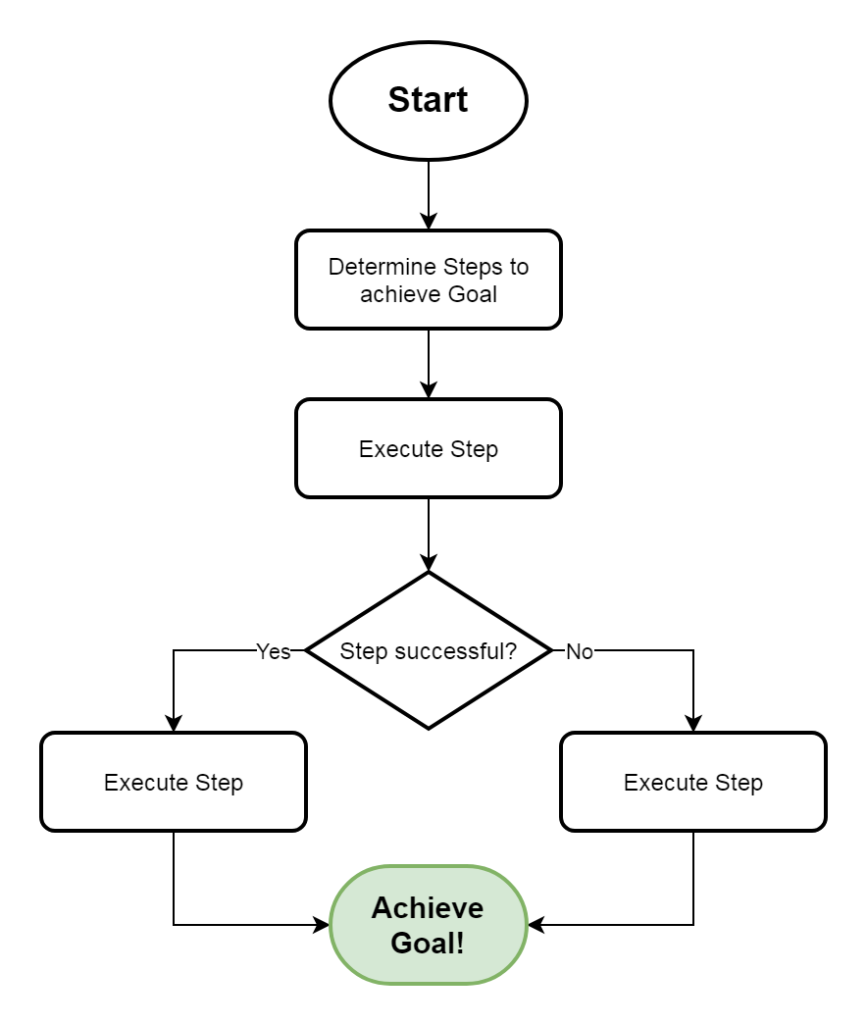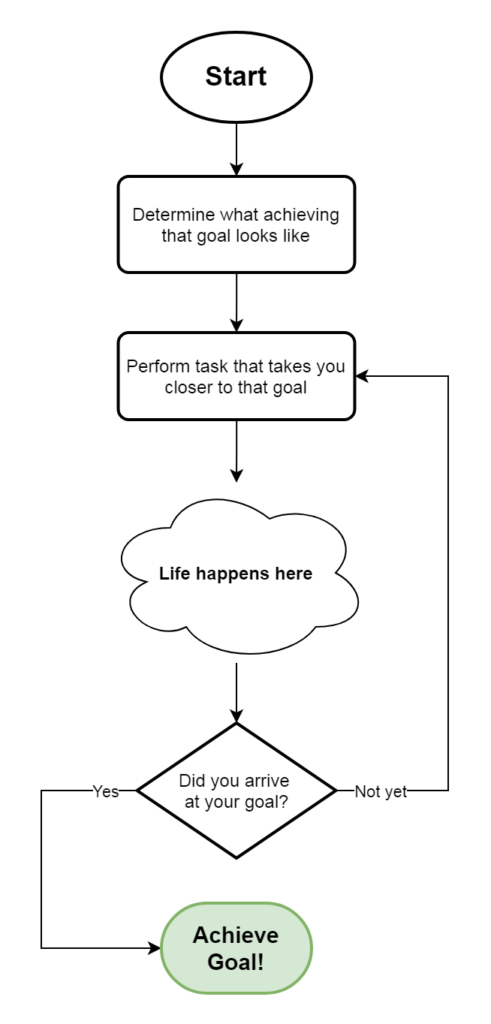Goals come in all shapes and sizes. Life goals, year-end goals, New Year’s resolutions, Quarterly targets, and so on. A common approach to goal setting is:
- Step 1: Define end goal
- Step 2: Enumerate the steps needed to achieve that goal
- Step 3: Perform the steps that were identified
- (Hopefully) achieve the goal
This simple flowchart illustrates this:

In computer programming, when you define the actions step by step until you reach your desired state, it is called imperative programming. As this same concept is evident in the diagram above, we can call this Imperative Goal Setting. When your plan consists of executing specific steps and actions, then your plan is imperative.
This approach makes sense, but in reality, things are not as straightforward as we want them to be. Life can (and will) throw a wrench in the middle of our perfectly-crafted plan. How then can we deal with this uncertainty?
Declarative Goal Setting
What if instead of defining each step and action in detail, we just define the end goal?
Having just an end goal allows us to be flexible in the steps we need to achieve it. As we cannot foresee all of the possible ways our plan can go wrong, then this flexibility will help us to better deal with the problem when it happens.

This may seem like a haphazard way to achieve our goals, but as long as the steps you are taking move you closer to your desired end-state, then you are still progressing. When you encounter an unexpected event or result, step back, re-calibrate your position, and then execute the next evident step.
Life is Unpredictable
We already know that things do not always go the way we want it to be. A popular saying in the military is:
No plan survives contact with the enemy.
No matter how long it took and how perfect your plan is, this can still fail because we can control neither the environment nor other people. If our plan relies on others (like our boss, our clients, or our co-workers) to act in a certain way, then it is a recipe for failure.
A declarative approach provides the necessary flexibility once unexpected events come into play. For example, if you have a goal of reading at least one book a month, then you might set a number of hours that you must spend reading per day. The idea is, if you allocate 30 minutes to 1 hour of reading each day, you will eventually achieve your goal for the month.
But what happens if you get sick, or one of your family members became ill and need your care? This will invariably affect your daily schedule and thus your reading. By focusing on the end goal (finish reading one book a month), then we could come up with multiple ideas that we can do to achieve it:
- “Reading” does not necessarily mean consuming a physical book. We can also use other forms of media such as an audiobook.
- By using an audio format, we can listen to the book while doing other menial, physical tasks without affecting our understanding, and thus save time.
- Instead of setting up a daily reading target, set a weekly or a bi-weekly one. On some days you have more free time, and so can read more, but on some days you can’t. You can then do “advance” reading to make up for those days.
Don’t freeze
If your plan is rigid, you often get stuck when something unexpected happens. It is impossible to define all possible events that may occur and affect our plan. As the previous point highlighted, life is unpredictable.
What do we do in these circumstances? Instead of trying to fit your existing plan with the current situation, perhaps we can ask these questions:
- Can we postpone this action until the near future, and then compensate for the lost time?
- Did this unexpected event actually open a new opportunity for me to move a step closer to my goal?
- Does the event highlight the fact that there is actually a more important goal for me to pursue compared to what I am currently moving towards?
Take the side road
Let’s say you are walking one day and you notice a small path that no one else seems to be taking, aren’t you curious if that path will lead you to your destination faster? The same thing happens in life. There are some events or circumstances that surprise us or catch us off-guard. In the end though, that event opened up a path and enabled us to pursue a better, more enjoyable direction.
If your plan does not depend on very specific steps, it allows you to explore other ways that may not be obvious at first glance. In our previous example of setting a monthly goal of a book per month, the “side road” approach would be to listen to the audio version instead of reading the physical book.
Be gentle with yourself
Loss aversion is an interesting concept. It says that we prefer to avoid a loss rather than gain an equivalent amount. We do feel a more intense emotion when we lose a hundred bill, as compared to finding the same hundred bill lying on the ground.
A related concept to this is is that we feel much worse when our plan fails, than we feel good when we succeed. There is an added element of guilt, regret, and shame that accompanies failure to accomplish a plan. When your plan is flexible however, that negative feeling is reduced as there is no attachment to a specific action. We are free to step back, re-calibrate, and take an alternate path.
When something goes wrong, we don’t need to beat ourselves up about what happened. Look for new opportunities and take the side road instead.
Focus on the goal, not the plan
We should always be looking at the end goal while executing our plan. The goal is like the north. No matter which direction you are walking, the compass always points to the north. No matter the situation you are in, keep yourself oriented towards the goal.
- Is what you are doing right now relevant to what you are trying to achieve?
- Are you encountering a stumbling block, or is it just a distraction?
- While knee-deep in things, are you ignoring that narrow path on the side that can move you further?
- Is the goal still worth achieving?
Always looking at the goal not only helps in making sure you are on the right path, but it also helps you actually achieve that goal. This concept is not new, and has been discussed by books and literature since Napoleon Hill.
The idea is that mind and matter are intertwined. By focusing your thoughts and your feelings towards the achievement of a goal, you can actually influence your environment. By actually living your goal, the environment (or the universe, if you prefer) work in the background to make your goal the reality.
Experience having achieved your objective even before you arrive. Feel how much joy you will feel once you obtain that goal. Let gratitude flood your mind, thankful that after all the struggles along the way, you have finally made it.
This point is explained beautifully in Christian literature:
Faith is to believe what you do not yet see; the reward for this faith is to see what you believe.
Saint Augustine
Photo by Estée Janssens on Unsplash